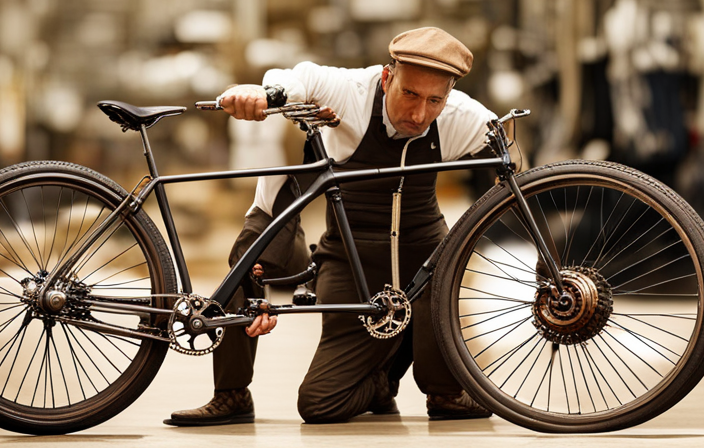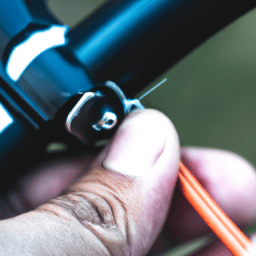Picture yourself cruising on a bike, feeling the wind in your hair and the sense of freedom flowing through your veins. However, what’s this? Rust on your handlebars, gradually wearing away your happiness?
Fear not, for I am here to guide you on how to remove that pesky rust and restore your handlebars to their former glory. In this article, I will provide you with step-by-step instructions, using simple tools and materials, to effectively get rid of rust and ensure a smooth and enjoyable ride.
So, let’s dive into the world of rust removal and reclaim your biking experience!
Key Takeaways
- Assess the level of rust damage on the handlebars (light, moderate, severe) to determine the appropriate course of action.
- Use a mild detergent and warm water mixture to clean the handlebars, paying special attention to rust-affected areas.
- Apply rust remover or vinegar solution to penetrate and remove rust, scrubbing with a wire brush or steel wool.
- Finish by applying rust converter or primer, sanding rough areas, and applying a protective coating or paint to restore the handlebars’ appearance.
Gather the necessary tools and materials
You’ll need a few tools and materials to get started. First, gather the necessary tools and equipment, including a wire brush, sandpaper, rust remover, a clean cloth, and some lubricant. These items are essential for effectively removing rust from your bicycle handlebars.
Additionally, it’s important to take safety precautions. Wear protective gloves to prevent any injuries to your hands, and make sure you’re working in a well-ventilated area to avoid inhaling any harmful fumes from the rust remover.
Once you have all the tools and safety measures in place, you can proceed to inspect the extent of the rust damage. This will help you determine the best course of action for removing the rust and restoring your handlebars to their original condition.
Inspect the extent of the rust damage
First, take a look at how much damage the rust has caused on your bike’s handlebars. Assessing the damage is crucial in determining the appropriate course of action. Use a rust inhibitor to stop the rust from spreading further and to protect the handlebars from future corrosion. The table below provides a visual representation of the different levels of rust damage and the corresponding actions to be taken.
| Rust Damage Level | Action |
|---|---|
| Light | Apply rust inhibitor and use a soft brush to remove the rust. |
| Moderate | Apply rust inhibitor, use a wire brush or sandpaper to remove the rust, and consider repainting the handlebars. |
| Severe | Apply rust inhibitor, use a wire brush or sandpaper to remove the rust, and consider replacing the handlebars if necessary. |
Next, clean the handlebars with a mild detergent and water to remove any remaining rust particles and dirt.
Clean the handlebars with a mild detergent and water
After assessing the extent of the rust damage, I proceeded to clean the handlebars using a mild detergent and water. Cleaning the handlebars is an essential step in removing rust and ensuring their longevity.
To begin, I mixed a small amount of mild detergent with warm water in a bucket. Using a soft cloth or sponge, I gently scrubbed the handlebars in a circular motion, paying special attention to the areas affected by rust. This technique helps to remove dirt, grime, and surface rust.
For stubborn rust spots, I employed alternative rust removal methods such as using a paste made from baking soda and water or applying lemon juice and salt. These techniques effectively loosen the rust, making it easier to remove.
Transitioning into the next section, the cleaning process sets the foundation for the subsequent step of using a rust remover or vinegar solution to remove the rust.
Use a rust remover or vinegar solution to remove the rust
To effectively remove the rust from your handlebars, try using a rust remover or a vinegar solution.
Rust removal techniques are essential for maintaining the integrity of metal surfaces and preventing further damage. Rust can weaken the handlebars, making them more prone to breakage or failure over time.
A rust remover, such as a commercial product or homemade vinegar solution, can effectively dissolve the rust and restore the handlebars’ condition. Apply the rust remover or vinegar solution to the affected areas and let it sit for a few minutes to penetrate the rust.
Then, use a wire brush or steel wool to scrub the handlebars, loosening and removing the rust. This step will prepare the handlebars for further cleaning and restoration.
Scrub the handlebars with a wire brush or steel wool
Using a wire brush or steel wool, scrubbing the handlebars will help remove the rust and restore their condition. Both the wire brush and steel wool are effective tools for this task, but they have some differences. The wire brush is made up of bristles that are usually made of steel or brass, while steel wool consists of fine steel fibers. The wire brush is great for removing loose rust and dirt from the surface of the handlebars, while steel wool can be used to scrub off stubborn rust spots. Alternatively, there are other rust removal methods available, such as using a rust remover or a vinegar solution. After scrubbing the handlebars, it is important to rinse them thoroughly and dry them completely to prevent any further rusting.
Rinse the handlebars thoroughly and dry them completely
Make sure to thoroughly rinse and completely dry the handlebars to prevent any further rusting.
After scrubbing the handlebars with a wire brush or steel wool, it is essential to remove any residue and rust particles by rinsing them thoroughly. Use a hose or a bucket of water to rinse the handlebars, making sure to reach all the nooks and crannies. Pay close attention to areas where rust may have been deeply ingrained.
Once you have finished rinsing, dry the handlebars completely using a clean, dry cloth or towel. Moisture can accelerate the rusting process, so it’s crucial to ensure that the handlebars are completely dry.
By following these rust removal techniques and preventing rust on handlebars, you can prolong their lifespan.
Now, let’s move on to applying a rust converter or primer to prevent future rusting.
Apply a rust converter or primer to prevent future rusting
Once you’ve thoroughly rinsed and dried the handlebars, it’s time to apply a rust converter or primer to help prevent future rusting.
When choosing between a rust converter and a primer, it’s important to consider their effectiveness. Rust converters are chemical solutions that convert rust into a stable compound, stopping further corrosion. They work best on light to moderate rust and are easy to apply.
On the other hand, primers create a protective barrier between the metal and the environment, preventing rust from forming. They are available in different types, such as oil-based or epoxy-based, and offer better adhesion for subsequent paint layers.
To make an informed decision, consider the severity of the rust and the desired outcome. Once you’ve chosen the appropriate product, apply it according to the manufacturer’s instructions. This will ensure maximum effectiveness in preventing future rusting.
Moving on to the next step, we will discuss how to sand the handlebars to smooth out any rough areas.
Sand the handlebars to smooth out any rough areas
To ensure a smooth finish and remove any remaining rust, it is crucial to sand the handlebars thoroughly. This step will help eliminate rough areas and create a suitable surface for the next stage of restoration.
When sanding bicycle handlebars, it is essential to use the correct sandpaper grit and techniques. Here are some effective sanding techniques to consider:
- Start with a coarse grit sandpaper, such as 80 or 100, to remove the rust and roughness.
- Gradually progress to finer grits, such as 220 or 320, to achieve a smoother surface.
- Use long, even strokes to sand the handlebars, moving in the same direction.
- Pay attention to curved areas and corners, ensuring they are adequately sanded.
- Regularly clean the handlebars and sandpaper to prevent clogging and achieve optimal results.
If sanding seems too laborious or time-consuming, there are alternative rust removal methods available. However, sanding provides the best results for achieving a smooth surface.
Transitioning into the next section, applying a protective coating or paint will restore the handlebars’ appearance and protect them from future rusting.
Apply a protective coating or paint to restore the handlebars’ appearance
Applying a protective coating or paint will help restore the appearance of the handlebars and safeguard them against future corrosion.
There are several benefits to using a protective coating on bicycle handlebars. Firstly, it acts as a barrier between the handlebars and external elements such as moisture and salt, which can cause rust.
Secondly, it prevents scratches and peeling of the paint, keeping the handlebars looking new for a longer period of time. Additionally, a protective coating can enhance grip by reducing slipperiness.
When choosing a protective coating, consider the type of handlebars you have. Different types of bicycle handlebars, such as drop bars or flat bars, may require specific coatings or paints.
To ensure the best results, follow the manufacturer’s instructions when applying the coating. By regularly cleaning and maintaining your bicycle, you can prevent future rust buildup and extend the lifespan of your handlebars.
Regularly clean and maintain your bicycle to prevent future rust buildup
Regularly cleaning and maintaining your bike can help prevent future buildup of rust on the handlebars. Here are three maintenance tips to keep your bicycle rust-free:
-
Keep it dry: After riding in wet conditions, make sure to dry your bike thoroughly. Moisture and humidity can accelerate rust formation, so use a clean cloth or towel to wipe down the handlebars and any other metal parts to remove any water or moisture.
-
Lubricate regularly: Apply a thin layer of bicycle-specific lubricant to the handlebars and other metal components. This will help create a protective barrier against moisture and reduce friction, preventing rust from forming.
-
Store it properly: When not in use, store your bike in a dry and well-ventilated area. Avoid leaving it outside exposed to the elements for long periods. Consider using a bike cover or storing it indoors to protect it from moisture and rust.
By following these maintenance tips, you can prolong the lifespan of your handlebars and prevent rust from becoming a recurring issue.
Frequently Asked Questions
How often should I clean and maintain my bicycle to prevent rust buildup?
To prevent rust buildup on your bicycle, it is recommended to clean and maintain it regularly. Lubricating your bicycle chain every 100-200 miles can help prevent rust. Common causes of rust on handlebars include exposure to moisture and lack of proper maintenance.
Can I use any type of mild detergent to clean the handlebars, or is there a specific one recommended?
Can baking soda effectively remove rust from bicycle handlebars? What are the differences between various handlebar grips in terms of grip and comfort? Let’s explore these topics in a technical and informative manner.
Is it necessary to use a rust converter or primer after removing the rust, or can I skip this step?
I recommend using a rust converter or primer after removing rust from bicycle handlebars. This step is crucial for rust prevention and ensures the handlebars remain in good condition. It is one of the best practices for handlebar maintenance.
What type of protective coating or paint should I use to restore the handlebars’ appearance?
To restore the appearance of the handlebars, I recommend using a protective coating or paint. There are various options available, such as clear lacquer, enamel paint, or powder coating, which provide durability and a smooth finish.
Are there any alternative methods to remove rust from bicycle handlebars, other than using a rust remover or vinegar solution?
When it comes to removing rust from bicycle handlebars, there are alternative methods available that don’t involve the use of traditional rust removers or vinegar solutions. These natural rust removal techniques can be just as effective.
Conclusion
In conclusion, removing rust from bicycle handlebars is a straightforward process that can be done with a few simple steps.
By using the right tools and materials, inspecting the rust damage, and utilizing a rust remover or vinegar solution, you can effectively restore your handlebars to their former glory.
Remember to regularly clean and maintain your bicycle to prevent future rust buildup.
As the saying goes, ‘An ounce of prevention is worth a pound of cure.’ So, take the necessary steps to protect your handlebars and enjoy a smooth and rust-free ride.









